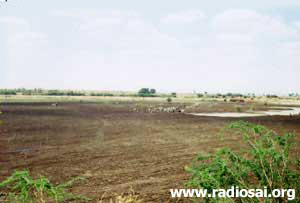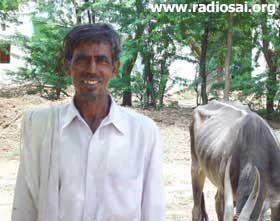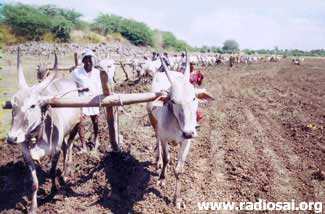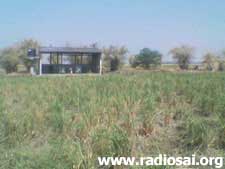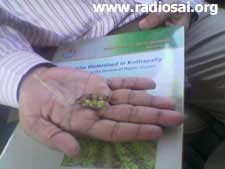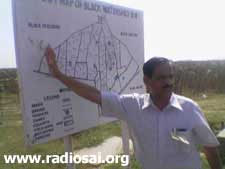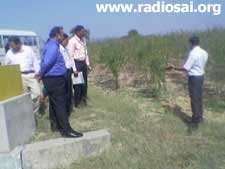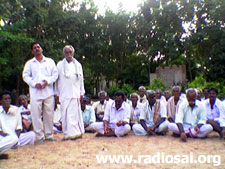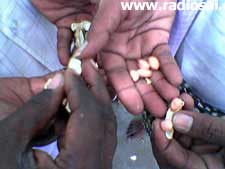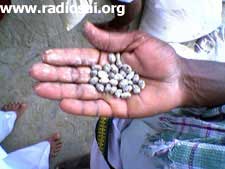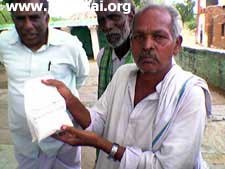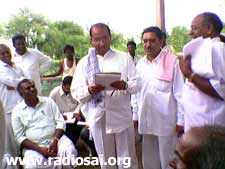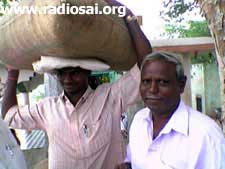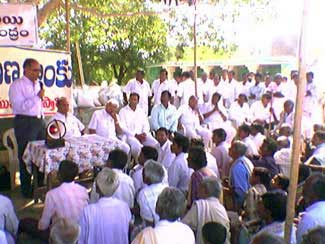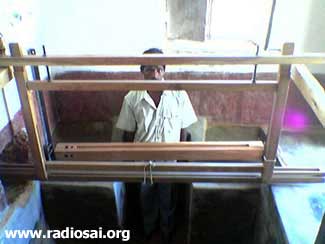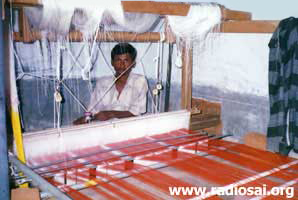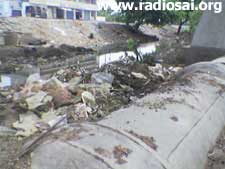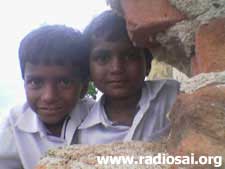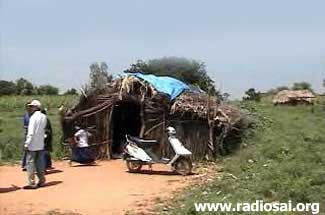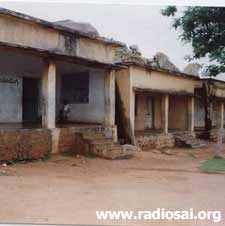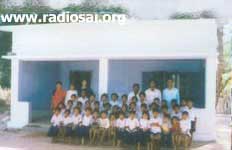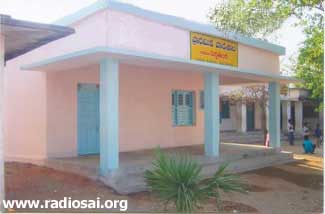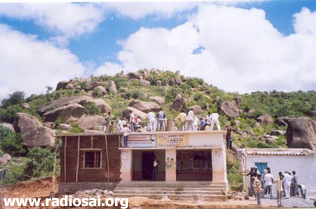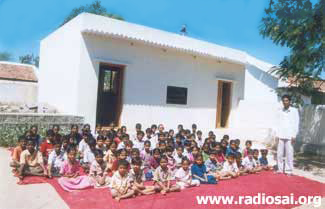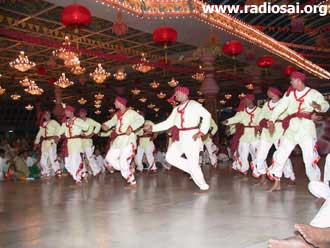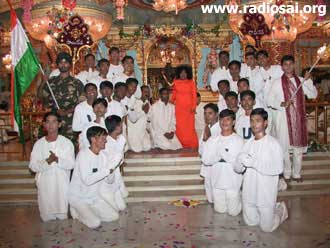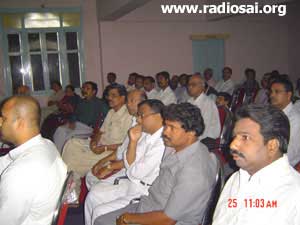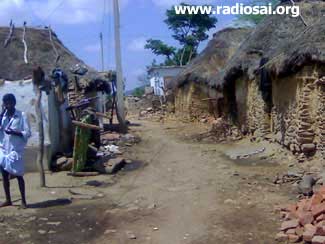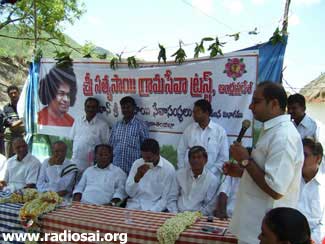The Case of a Community’s Collapse
Ramadasu was a statue of dejection and despair. His three sons had deserted him. They had no more faith in their father’s profession. It was the fourth year in succession when Ramadasu found only a dry dreary earth for all the long hours of toil that he had put in under the unforgiving Sun. “I can swallow converting my sweat into blood to cultivate my land and still get a piece of burnt earth, but what do I do about the loan?” Ramadasu was almost in tears.
That was the year 2003 and since 1999, the five hundred odd residents of Cholamarri - the village where Ramadasu was born and brought up - had never seen a single good rain. “It had never been so bad,” says Ramadasu who has lived through more than forty summers and winters in his hamlet.
Every year he would borrow Rs. 10000 or Rs. 15000 from the bank to buy seeds and plow his land hoping against hope, “If this year I get a good yield, I can repay all my loans”. And every year it would be a disaster more severe than the previous. He has a large area of land – 12 acres. But no food to eat. He is one of the poorest in the village with at least Rs. 50000 against his name as arrears in the bank. He can sell his eight animals – a few buffalos and cows – and clear his loan. But how will he cultivate again without the plough? With eight animals and a big patch of land, Ramadasu is tragically still very poor. And now he resorts to the final option – sell his animals. With tears Ramadasu every year sends one or two of his buffaloes to the slaughter house for half the price he bought them for a few years ago. It was as if he was he was cutting his own stomach with a knife. But what else could he do? |
|
 |
Ramadasu just like his land was pitiable,
hopeless and burnt out |
|
Swami Initiates ‘Sustained Rural Development’
In the November of 2003, when Sai Youth from Andhra Pradesh reached this obscure village and asked the villagers how they could help, “Fodder” was the unanimous reply. “Please save our cattle, Sir. They are dying. Without them our profession is doomed.”
But how to grow fodder in this dry land? The Youth were clueless. Getting them fodder from outside for one year will not solve their problem. They needed a sustained development project. In fact, that was what Swami had specifically instructed them just a few months ago when they had all assembled in hundreds in Prasanthi Nilayam on the 20th of October 2003.
 |
"Start sustained village service" - Swami |
|
|
“All these years you have been visiting villages and conducting medical camps or have been doing some physical activity going once in a while. But, this is not going to help the villagers much. You must concentrate on the long pending unsolved issues the villagers are facing. Look to focus more on sustained rural development activity which will help them in the long run,” Swami said.
In fact, Swami took all the Youth by surprise when He declared out of the blue,
“I have decided to form a Sri Sathya Sai Grama Seva Trust to facilitate you to continue lasting village service.”
He even immediately gave the first cheque. “Where shall we start the work, Swami?” The Youth wanted explicit directions and guidance.
“Start with A – Anantapur district,” Swami had said.
|
That was the beginning of what turned into an avalanche of Sai Seva of gigantic proportions. Since then the Youth have embarked upon half a dozen sustainable development activities for rural areas and as you read along you will see how the success of one activity led to another. The Youth virtually covered the whole spectrum of village development in the state of Andhra Pradesh with resounding success. For now, let’s return to Cholamaari.
I. Providing Fodder to the Starving Cattle And Crafting a Turnaround - The Sai Youth's First Project
So, it is with this renewed enthusiasm and direction from Bhagawan that the Youth had come to Cholamaari after a long search of different villages in the Anantapur district looking for the neediest. And having come they were now determined to evolve a solution to this “fodder” problem. They conducted an extensive survey of the village, spoke to the villagers, had brainstorming sessions among themselves and out came an idea. “Can we not use the village lake bed? The lake bed of the village has inherent moisture and this could just suffice to grow fodder,” they contemplated. The sporadic and scanty rains that the village received did contribute to the wetness of the earth which was once a lake spread over more than four hundred acres.
But there were several knotty issues to be resolved. The lake bed, by order of the Government, could not be cultivated. It did not belong to any specific village either as it was shared by a cluster of five villages spread all around the lake – Cholamaari being the biggest. So the first step was to meet the district Collector. Getting an appointment, they were soon in the office of Ms. Anuradha, the former Collector of Anantapur.
“You Must Not Delay Good Work” - Swami
The Collector seemed impressed and was more than eager to help the inspired Sai Youth. She immediately came to Prasanthi Nilayam and Swami graciously blessed her with an interview. A few minutes into the interview and Swami was out. He beckoned to Sri Y Srinivas, the President of the Sri Sathya Sai Grama Seva Trust and said,
“You must not delay good work. Start this immediately.”
|
|
|
The 442 acres of lakebed - the solution to the
villagers' woes lay in this wetbed |
|
The Youth now were literally unstoppable! They had no more apprehensions whatsoever – should they deal with the Government, should they speak to all the five villages, what if the project just did not succeed, and the like.
The Collector cautioned them that it was not going to be easy. It was going to be a Herculean task to convince the villagers of the efficacy of the project and persuade them to take to the soft earth with their ploughs. And the even trickier issue was that there was no way they could do the project unless they forged a consensus about it in all the five villages around the lake. Otherwise it would be a war - the Youth knew this well and this was the last thing they wanted.
|
Drought resistant 'African Grass Sudan Variety'
fodder being sowed |
|
|
The Collector on her part did all she could. The seeds for cultivation - a special variety of drought resistant seeds called the African Grass Sudan Variety which would cost tens of thousands - came from the Government free of cost.
The Collector even shared with the Youth that there are good sums of Government funds under different schemes which are available for the villagers, but most of the time they remain unspent. And she is most happy releasing those funds to the Youth as she is impressed with their sincerity of purpose and is confident about their ability to deliver results. Soon the requisite permissions to cultivate the land arrived too.
Having won the confidence of the local administration, the next step was to build a cordial relationship with the villagers of Cholamaari and then unite all its five neighboring villagers. The Youth achieved this more by actions than by words. |
The village was not new to Sai as Swami’s drinking water project had reached their surrounding areas. And the village had a small Bhajan mandali established a few years ago. The Youth taking Swami’s Name conducted medical camps, visited the villages frequently and gave a sympathetic ear to all their problems – all this sent very positive signals to the village community. They started to believe “Yes, these Youth are really concerned about us. They are here to help us with no ulterior motives.” Once the villagers became more receptive, the Youth then convinced them of the many positive fallouts of the fodder project and how if all the villagers would unite it would do maximum good to maximum people. And in a few weeks the five villages began to work as one cohesive unit. For the villagers themselves, it was a miracle!
|
|
|
|
More than 150 ploughs and 500 farmers from five villages worked unitedly for three days to chart a new chapter in their lives.... |
“We never thought we would work with untouchables before” – A Village Community
“We had never thought that we would work with people from the Harijanwada (untouchable colony) before,” said one community of villagers, “But, today we do not feel the same inhibition anymore as we were working with them throughout these few months. We have learnt that all are humans and that there is no other difference.”
It is this sense of camaraderie which the Youth feel was the most potent fallout of the project apart from the nearly 500 bullock-cart loads of fodder that grew in three months in mid-2004.
“It grew 5 to 6 feet high. I got three bullock-cart loads,” say Govindappa with jubilation. He, like all his 150 odd brethren, had worked for three days on the fields with his plough in the January 2004. And every drop of sweat was worth it.
“The fodder is like a goldmine for me ” – Ramadasu
Ecstatic Ramadasu now says, “The fodder that we cultivate in this lake bed is like a gold mine. I use it very sparingly. It is my reserve for the dry months. I will not sell my remaining animals. Now I even sell milk from my cow everyday in the village.”
The villagers have cultivated fodder many times after 2004 and do so with great enthusiasm every year. Another group of villagers from the neighboring village said to H2H,
“These Sai Baba people (organization) have saved us.” With immense gratitude on their faces they continue, “We would have definitely left the village for lack of sustenance (just like Ramadasu’s sons) if not for this project. God bless them all.”
|
|
|
Ramadasu so happy now with his animals, his land, his life... |
|
“This project has brought so much unity among us” – Sri Kulyappa, the Village Sarpanch
When H2H asked the Sarpanch (local Government head) of the village, Sri Kulyappa, if they would continue this project, he said,
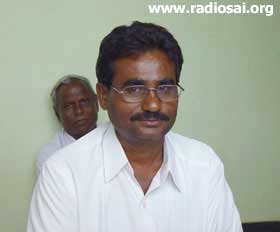 |
"The whole atmosphere in the village has changed"- Sri Kulyappa, the Village Sarpanch |
|
|
“Yes. We want to continue this every year at all costs. This project has brought so much unity among us. It has shown us what we can achieve if work together for each other. We will even borrow bullocks if required and do this project to save our remaining animals. The whole atmosphere has changed so much since the Sai Youth came to this village.”
“We are waiting when the Grama Seva Youth will come again to our village. We want them,” said Ramaiyya, another elder of the village who coordinates all the activities with respect to the project with the villagers.
When the fodder was cut for the first time in 2004, it was the culmination of a series of sincere efforts by the Youth. It was a great occasion to celebrate and an occasion to reflect too. The Youth were more confident than ever in their abilities and had learnt very salient lessons. |
First and foremost is that if the project addresses an urgent need of the village, then the beneficiaries of the project can be convinced about it with minimum effort. And once they are convinced, the work is already half-done. As Sai Prasad Gollapudi, a member of the Grama Seva Trust said to H2H,
“If you noticed, the need of the villagers drove them to work with unity towards the completion of the project. We know that we should look at such projects where the need is so great that the villagers themselves come forward to work for it. For example, this project had most of the village farmers working and not the volunteers.”
|
|
|
The villagers clearing the wild bush growth (left) before tilling the land to sow the fodder seeds yet another year |
“The whole project was accomplished with just three volunteers and without spending a pie!” – Sri Y Srinivas
“Yes, that was another amazing feature of this Project, “adds Y Sreenivas, “Here we had hundreds of families benefiting from five villages from a big project involving so many parties – the Collector, the village heads and different groups of farmers – but all this was achieved with just three Sai volunteers and without spending a single pie!”
It just shows how to undertake large projects, and that what is necessary is the sincerity of purpose and clarity of thought and a sense of surrender to His will. Funds for any worthy undertaking are the last thing to worry about - the Sai Youth were more convinced than ever before about this fact.
The “Fodder Project” was a grand success no doubt but still it was not a comprehensive solution to the villagers’ miseries. At best, it served only the animals in the lean months and kept the families together. But the primary problem with the villagers was the single dreaded thing – drought. And this was the issue that the Youth next wanted to tackle.
II. Taking the Scientists To The Villagers To Deal With the Droughts - Their Second Project
The farmers never had timely rainfall and the three main crops they would cultivate - groundnut, castor and pigeon pea were all dependent on rains. And there was no groundwater either to be able to sink bore wells. Surely, you can do little about the vagaries of nature but the Youth believed they could do something with aspects which were under the control of the villagers like the seeds, the land, the pesticides, etc. They examined various factors and thought it was best to take guidance from experts in the field. And this was how they found themselves in the campus of ICRISAT- International Crops Research Institute for the Semi-Arid Tropics [a UNO arm which works primarily in Africa] in the city of Hyderabad.
|
|
|
The experimental lab in ICRISAT |
The experimental crop in arid land |
The Youth with the scientists in their office |
“Do the scientists at ICRISAT have a solution to the woes of the villagers of Cholamaari cluster?” was their moot agenda. And the answer - an emphatic “Yes.” The Chief Scientist, Mr. S.P Vani and his colleague Mr. Gowda, the Global Theme Leader, took the Youth around their labs and fields where they were testing drought resistant varieties of crops. The Youth were indeed glad. They immediately knew they had come to the right place. And the Scientists too working for the UN, which is also essentially a non profit organization, evinced keen interest in helping the farmers of the drought-affected Anantapur district.
|
|
|
Quality drought resistant seeds |
How cropping was implemented in Africa |
'A successful crop despite drought' - scientist |
The scientists even mentioned, “It is sad that despite there being such a great need in our country we are here trying to help only farmers in Africa.” So this was a welcome opportunity for them and they looked forward to visiting the village and sharing their research with the farmers. And this happened very soon.
ICRISAT Scientists at the Farmers Meet in Cholamaari
In a matter of days, on one sunny weekend the Scientists drove down along with members of the Grama Seva Trust to Cholamarri. Incidentally, that was the day of Raitu Mela – the farmer’s meet. The villagers knew about the Scientists visit and had all assembled before they arrived. And then began an illuminating session for the villagers where the Scientists explained farming techniques like Inter-Cropping and Integrated Pest Management. Everything they heard was new to them. They listened with rapt attention. The Scientists also showed them the quality seeds they had produced. The villagers saw the drought-resistant and superior quality groundnut and castor seeds. The farmers seemed to assimilate all that was conveyed to them. Many of them were proactive and asked questions narrating their practical problems. Having understood all that, the next important hurdle was, whether the villagers were willing to try these seeds the coming season? Will they be willing to take the risk?
|
|
|
Youth educating villagers on the new method of cultivation |
Some of the village farmers raise practical issues |
The scientists explaining to the villagers the new seed technology |
When the Sai Youth asked, “How many farmers are willing to experiment with the new seeds?” There was fortunately an encouraging response. The visit of the ICRISAT scientists paid off. The scientists finally took samples of the soil and promised to provide the first lot of drought resistant seeds to the farmers free of cost for their first experiment.
And true to their word, on a subsequent weekend, Dr. Lingaraj Jangvad, an ICRISAT scientist arrived at the village with a UN mini-truck loaded with seeds. Each farmer was given seeds according to the amount of land he was willing to set aside to try the new seeds. They got drought resistant groundnut, castor and pigeon pea seeds. The scientists also spent a lot of time explaining to the farmers how they should cultivate these crops, what pesticide to use, how to maintain the cultivation, etc. The scientists also gave them Azola - a bio pesticide.
|
|
|
Drought resistant groundnut seeds |
The quality castor seeds |
Villager showing azola - bio pesticide |
|
|
|
The Youth forming a select team of villagers to monitor the project |
Scientist explaining to the farmers how to cultivate the new variety of seeds |
A villager glad to receive his bagful of new drought resistant groundnut |
When we asked Yadagiri, a farmer, why did he believe the scientists and what gave him the confidence to go ahead with the new crop, he admitted,
“Initially, I was very apprehensive about the seeds and so many strangers (scientists) coming to the village. But, once they showed us the seeds and we tasted them, I was convinced. Moreover, the “Sairam people” had brought these scientists so I knew it would be for our benefit, so I decided to try out the seeds. I have 8 acres and had set aside 2 acres for experimenting. This time I will use all 8 acres with the produce I got. I also got a good price in the market.” Yadagiri is all smiles.
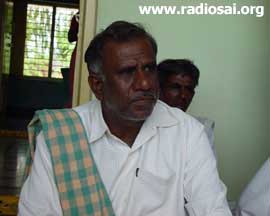 |
Rangaswamy's new groundnut crop doubled |
|
And Rangaswamy, an elder in the village, is actually on cloud nine. “I got double the produce I used to get with the normal seeds. I am willing to cultivate all my 20 acres with the new seeds now,” he said to H2H, with a gentle grin on his face hiding his inner exuberance in consonance with his age.
“The Government may have forgotten us but God has not forgotten us” –- Ramaiyya, a Village Elder
What Ramaiyya, another village elder said to the Sai Youth literally turned their hearts into sponge. “We always looked forward to the Government to come forward to help us. But, you people have come. The Government may have forgotten us but God has not forgotten us. That is why He has sent you.”
|
|
For the Sai Youth the whole project was another soul-stirring experience. It was yet another exercise where they acted as just able facilitators. In the “fodder project”, they brought the Government and villagers together and now in this the intellectuals and farmers were face to face sharing each others’ experience.
“It is precisely this role that we want to play,” says Balachandra, a Sai Youth. “There are a number of Government schemes, agricultural institutions, ideas and more ideas which are not reaching the people they are meant for. All we need to do is to create a forum where the experts and the people who can benefit from this expertise meet.”
Sri Y Sreenivas, the President of the Grama Seva Trust, says, “Despite being involved in rural activities for the last decade, we have never done anything like this before. We will monitor this for some time and if it turns out to be successful, we will implement it in other areas of the state which are prone to droughts. This has been such a wonderful learning experience for all of us.”
The ICRISAT project is still in its pilot phase in Cholamaari cluster. Not every attempt was completely successful. While the new variety of groundnut seeds did extremely well, this could not be said of other seeds where the yield did not match up to the scientists’ expectations. With the Youth submitting the feedback report from the villagers to the scientists there is further research going on now in ICRISAT. |
|
 |
Very happy to receive his share of new seeds |
|
Therefore, just like the fodder project which had its utility limited to a few lean months, the ICRISAT project too, though successful, had its own shortcomings. There is more research needed on some seeds and there was an element of dependence on nature, however, small that may be. To really yield good crops the drought-resistant seeds needed blessings from heaven - even if it is a little at the right time. And with no groundwater whatsoever, the farmer had absolutely no backup. So in spite of continuing their efforts to make these projects fool-proof, the Sai Youth were still exploring other options which could provide lasting self-employment to the villagers all the year round and where the uncertainties to deal with were minimal.
III. An Innovative Scheme That Made The Precious Youth Stay In The Villages! - The Youth's Third Endeavour
In their quest for such alternate schemes, the members of the Grama Seva Trust constantly interacted now with the youngsters of the village. Every passing day the village was losing its young men. Just like Ramadasu’s sons, no youngster wanted to take up agriculture and they were all only dreaming of ‘doing it big in the city’, and were moving away from their homeland. For the village elders, this was a major concern, but they were helpless, the Sai Youth gathered.
“My dream had become dust” – Ramakrishna
B Ramakrishna, a youngster of the Nallur village (one of the villages in the Cholamaari cluster) has no parents. Filled with the zeal to make a life for himself, he fled the village to the nearby town of Hindupur when he was not even fifteen.
“I worked as a labourer under a Handloom weaver in Hindupur,” he says, “But even after three years of dedicated labour, he still paid me very little. I could not even make ends meet. My skill and dedication was never rewarded. In the city, the expenses too were very high. I realized I can never do anything on my own in this city. I never wanted to be a labourer forever. I was thoroughly dejected. My dream had become dust. I returned to Cholamaari,” shares Ramakrishna.
In the meantime, Ramakrishna got married and thanks to his in-laws he had a thatched hut to stay in the village. With no land, no parents, no assets whatsoever, Ramakrishna had no option but to work as a labourer now in his own village, however much he disliked it.
“For two years I worked as a daily wage labourer earning Rs. 30 or Rs. 40 on the days I found work. There were times when for days I would find no work. It was so terrible,” Ramakrishna’s face shrinks. He does not want to talk about those horrific days of his life.
|
|
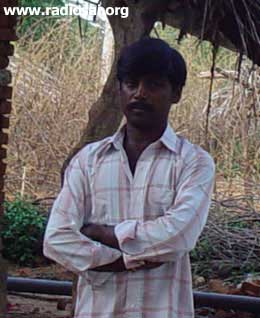 |
Ramakrishna's life was in shambles... |
|
It was during this time, that the Sai Youth approached Ramakrishna and asked him if he was willing to go the Anantapur District Vocational Training Centre in Hindupur for two months. There he would learn weaving from experts and at the end of it he will also get a certificate, the Sai Youth explained to him. Ramakrishna gave his name. “And this was the turning point of my life,” says Ramakrishna.
Like Ramakrishna another 20 youngsters went to the Vocational Training Centre. Their food and accommodation were taken care of by the Grama Seva Trust. In two months, these boys were ready to set up their own handlooms. And now the Sai Youth approached the Anantha Grameena Bank, a Government-sponsored organization which is supportive of self-employment schemes for villagers. “But even they were reluctant to offer a loan. These youngsters, the bank knew, were very poor and did not have any property against which the bank could sanction a loan,” says a Sai Youth.
It needed a lot of persuasion at the highest level by the Youth. To convince the bank officials of their idea to make these youngsters self-reliant, the members of the Grama Seva Trust persuaded the Chairman of the bank to visit the village and see the work being done by the Grama Seva Trust and the Sai Organisation. The Chairman came and was impressed. He was convinced of their noble motives and sincerity of purpose. The Bank finally conceded to offer a loan of over two lakhs to be repaid in installments. The Sri Sathya Sai Grama Seva Trust gave the surety to the bank.
|
|
The Chairman of the Anantha Grameena Bank
speaking to the villagers |
One of the very first handloom sets installed in the
village with the bank's support |
“This is a dream come true for me” – Ramakrishna
So this is the story of how Ramakrishna is now a proud owner of a handloom in his own house. Brimming with confidence and surfing on delight, Ramakrishna says,
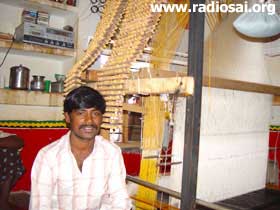 |
Ramakrishna is dream-weaving his life now... |
|
|
“It is a dream realized for me. I know in one more year I will have paid the entire loan and then this handloom will be mine wholly. The ‘Sairam people’ have given me so much confidence. They have unlocked my creativity. I want to do quality work. I want to work hard. I will never leave this village again. My life has found a new meaning.”
It is not only Ramakrishna - the story of every unemployed-youth-turned-skilled-weaver in the village is as moving as this. And all this did not happen without many more hurdles. Getting the loan and buying a handloom set cannot generate employment. There has to be a market for the produce and also a supplier who will give the raw materials – the yarn, the colours and other essentials. |
And for this, the Sai Youth reached out to Saree sellers in Anantapur and the nearby town of Dharmavaram. They fortunately found a willing trader who was a devotee of Bhagawan. This good Samaritan not only offered to buy the sarees from the village youngsters but also provided them with all the raw material they needed at cost. Now the loop was complete. And what more, the Sai Youth themselves bought the first few sarees. This filled the young artisans with tremendous confidence. Indeed, the sarees were of high quality and so beautiful, every Youth vouchsafes.
“It is amazing what these youngsters can do when they are given the opportunity and environment to blossom,” says a member of the Grama Seva Trust.
On their first visit to the village after setting up all the handlooms, a young weaver came up to one Sai Youth and offered a saree. When the Youth was about to pay him for it, the weaver said,
“No, no sir. If my parents were alive today, I would have offered clothes from my first product. But since they are not here, I am offering them to you, as you are like them. Please do not give me money for this.” That is not all.
Another young weaver Basha went to the Youth and said,
“It was my long cherished dream to have a handloom. However, I could never afford to get one because I did not have the money. But you have helped me realize this dream. I am extremely grateful to you. Please accept this saree. It is the first one I have woven.”
|
|
|
So happy to be in the village and earn well |
|
All these youngsters now spare Rs. 200 from every saree they sell to repay the loan.
“Of the Rs. 2,06,000 loan we had taken, the weavers had already paid Rs. 54,000 and within one more year, they would have paid all the amount due,” says Mr. C R Rao, a senior member of Sai Organisation who coordinates with the bank, the weavers and the Grama Seva Trust members. “They are all very serious about repaying their loan and owning the handloom”, he adds.
|
Nagamani delightfully shows her creation... |
|
|
“We will never let you down at any time” – Yellaiah
In fact, when a Sai Youth visited them recently, Yellaiah, a beneficiary of this project said,
“We are indeed grateful to you brothers who have given us this livelihood. We have decided that we should not let you down at any time and have therefore formed an association. This will ensure that none of us defaults the loan payment so that you are never put to any embarrassment. If any one of us defaults payment, the rest of us will ensure that the payment is made.” This is the commitment that these youngsters exude now towards the project. There is nothing more satisfying for the Sai Youth.
|
“Livelihood projects have been on our mind for sometime. We are looking at many ways of providing self employment for the villagers so that they don’t have to leave their villages when crops fail. The success of this experiment is such a heartening feeling for all of us. It worked essentially because of the dedication of the villagers themselves,” says a Grama Seva Trust member.
Yes, the dedication of the villagers is the key to the success of every project. In fact, it is this which is now changing the demography of Cholamaari. Ramakrishna who was unemployed a year ago is now training Venkatesan, another teenager of the village, in the skill in which he has become expert now.
“I do not want any teenager to go out of the village and suffer like me,” he says, “I will train as many teenagers as possible, so that they also learn this skill and feel secure about their future. I want them to lead a settled and happy life in the village itself just like mine,” says a jubilant Ramakrishna.
“The Handloom Project Is A Boon From Heaven” – Sri C R Rao
“What the Handloom project has done to the village is beyond estimation. It is a boon from heaven. Now every youth in the village wants to be a weaver and the skill is being imparted now from one to the other. The positive effects of this project are much beyond providing livelihood to a few individuals.
The Fodder project takes care of a few lean months, the ICRISAT project helps a few farmers but is still dependent on a little rain, but the handloom project is a perennial income-generating project which is successful in every way. There is suddenly so much opportunity in the village itself,” says Sri C R Rao, a member of the Sai Organisation, who stays in the village and coordinates various activities of the Sri Sathya Sai Grama Seva Trust.
|
|
|
The handloom set is a blessing beyond compare |
|
The Cholamaari village, which derives its name from the Chola kings who once ruled that area five hundred years ago, still has certain buildings with the ornate architecture of the 15th century. But they are no more ruled by anybody. If anybody has captured their imagination, it is only “Sairam”.
 |
| God's tiny yet mighty messengers in the village |
|
|
Bal Vikas classes are held regularly in this village and it is these students who are ideals for the village now. When we went to the small Sai Centre there, the little girls folded their hands and welcomed us with a loud “Sairam.” But what was astounding was that they were next chanting a Vedic hymn “Shanno mitrah Shann Varunaha….” This was Shiskshavalli which Swami’s students generally chant in front of Him in the Sai Kulwant Hall. How did they learn Vedam? It baffled us. And all the students who come to the Bal Vikas, we learnt, are the top 50 in the local school.
But what is more amazing is that it is these sweet children who have persuaded their parents to stop eating non-veg. They take baths everyday, wear clean clothes and keep their surroundings clean. Their devotion and dedication to Swami is something to be emulated by all. The Cholamaari cluster today is a “Sai cluster” in every sense. There is nobody who does not love Swami in these villages. The ways of the divine are mysterious but for those who can see there is an invisible element guiding and directing every selfless activity in the village.
|
IV. The Sai Youth Resurrect Hundreds of Schools - The Gurukula Seva Maha Yagnam Project
Enthused with the success of the activities in a village cluster, the Sai Youth next wanted to expand their horizon. They had gained profound experience from the Cholamaari service projects. Now they wanted to make a difference to the whole state. As they surveyed the state visiting a number of villages in different districts of Andhra Pradesh, one aspect which struck them the most was the dilapidated and neglected state of Schools in virtually every district of the state. And in many villages, the shade of a big tree was the classroom. It was pathetic to see how the future citizens of the country were being taught and trained. The Youth immediately knew what they should be doing next.
They got in touch with the right authorities - the District Education Officers and the Chief Secretary for Education for the state of Andhra Pradesh. The plan was to work on about 100 schools throughout the state. This included constructing new school buildings in many villages and renovating the existing schools in places where the building was in a pitiable state. It being a state wide project, the amount of planning and coordination needed was phenomenal and it is for this reason that the Grama Seva Trust teamed up with the Sri Sathya Sai Seva Organization of the state.
Primarily, there were 3 aspects they knew they had to work on:
- Firstly, to ensuring that there is proper infrastructure for primary education which included the building, the teaching aids and the playing equipment;
- Secondly, ensuring that there is the right attitude among the teachers;
- And finally, seeing to it that the villagers understood the importance of sending their children to the school and encouraging the little ones to study.
To put it in a nutshell, the total ecosystem of the school was to be built and sustained.
|
|
|
Condition of a school premises as observed during the survey |
A neglected school which was later
properly built by the Sai Org. |
The only remains of a school building in a thanda, a tribal village |
In dealing with the first issue pertaining to infrastructure, the Sai Organisation gave directives to each district to construct/renovate schools depending upon its capacity in terms of finances and manpower. All the 23 districts responded positively and in just a span of six months 110 schools were worked upon in various parts of the state.
Where schools had only one or two rooms, more rooms were added. In schools were the drains were blocked, they were cleared and surroundings of the school made hygienic for the students. Many did not have any teaching aids at all - be it blackboards or maps, charts or scales - these were made available.
|
|
|
This was the school building in Turkapalli village in
the Nalconda district |
|
The new school building built at the same site by the
Sai Organisation |
Many schools did not have electricity - they now had a power connection. And where the students were sitting under trees, new buildings were constructed. Nearly 48 schools were constructed from the foundation.
|
|
|
The state of the school building at Upparapalle village,
Ranga Reddy district during the survey |
|
The school building completely renovated now
by the Sai Youth |
|
|
|
The old and dilapitated school building in Narayanraopet, Khamman District (left) gets a complete makeover now |
It was not easy. Many Samithis lacked funds or manpower to be able to execute such a project. But resources poured in just at the right moment mysteriously. As Gangadhar, a Youth leader from Hyderabad says,
“There would always be a stage where we would feel that the water is getting over our heads. The costs would seem to be going beyond our estimates. But there would always, arise some solution and it was during such times that I would feel Swami’s unseen hand.” This is an experience which every Samithi involved in this project can relate to. Swami says for any selfless activity money is never a hindrance and every Sai worker knows what it means.
|
|
|
A new school in the Peddatanda Panchayat of Nalgonda district |
|
Another new school in the same district |
|
|
|
Additional rooms being added to Venkateswara Tanda
in Ranga Reddy district |
|
Mylaram Kindi Tanda, a tribal village in Nalgonda district
gets a new school |
The 'Software Aspects' Now Had to be Dealt With
While the buildings took care of the “hardware” aspect of the project what was more important to sustain this program were the “software” aspects, namely the teachers and the children.
It was shocking to note that a number of schools did not even have teachers appointed to them. And where there were teachers appointed, they either never turned up to teach or made an occasional visit - or even worse, they sent a proxy to go on their behalf to the village while they pocketed the salary from the Government and continued an alternate profession. In short, what was needed was a complete change in the mindset of the teachers. And to this end, the Youth undertook many initiatives.
They approached the District Education Officers and organized special training sessions for the teachers. They even brought 175 of them to Puttaparthi on a special mission and while they were here, they arranged talks by eminent educationists and inspiring teachers from Swami’s institute. Prof. Anil Kumar regaled them and at the same time illuminated them. They were now aware of the Sai system of education. They understood the nobility of their profession. They were told how the President of India, Dr. Abdul Kalam, says he always wanted to retire as a teacher. And when somebody asked what he would prefer to do once his presidential term expires, without a second thought he mentioned that he would go back to the teaching profession.
All these conferences and interactions did strike a chord in their hearts and the Youth noticed a visible change in their attitude. All of them promised they would contribute positively to the society now. But the Youth did not stop there. They conducted another teachers’ training camp and invited the State’s Chief Secretary of the Education department, Sri I. V. Subba Rao, to the grace the occasion.
|
|
 |
Prof. Anil Kumar inspired the teachers |
|
But the chief guest’s presence was kept a secret and he was requested to sit in the last row and observe the proceedings of the camp. During the interactive session at the end of the camp, the teachers came out with many of their grievances. They mentioned how it was difficult for them to travel long distances to reach the village they were appointed to; how they could not visit it everyday due to lack of proper transportation facility; how they could in no way settle in a village because there were no quality schools there for their own children and so on.
The Chief Secretary then was called onto the dais. The teachers were understandably surprised. But the Chief Secretary put everyone at ease. He said, “These issues would have never surfaced in a formal meeting,” and promised to do everything possible to address their concerns. He expressed his immense gratitude to the Sai Organization for making him aware of such subtle and important issues pertaining to his department.
“This one project (of Sai Org.) is enough to clean all the dirt that is in our system” – The Chief Secretary of Education
A few weeks later at the District Education Officers’ meet in West Godavari district, the Chief Secretary said,
“It is a shame that we have not been able to address these issues so far. The Sai Organization has taken up this wonderful task of revamping the educational system. This one project is enough to clean all the dirt that is in our system.” For the Youth and the Organisation, it was a well deserved pat, no doubt.
But the project was nowhere near its objective still. There was the third and most important aspect to deal with – the children. Actually it was more to do with the villagers who would never encourage their children to go to school. Creating awareness among the village populace was the next herculean task.
The only way it could be done was speaking to each family of the village personally, the Youth thought. So, they launched a door-to-door campaign and patiently explained the importance of education to the parents of every child. They were told how knowing a little bit of mathematics and knowing how to read and write would prevent them from getting cheated. They understood how their children could earn much more than what they are earning now and lead a better life if they studied in the high school. All this persuasive talking actually did wonders. Encouragingly, the villagers seemed willing to send their children to school once they were approached. Many of them even said that no one had ever told them earlier that it was so important to get educated.
They not only sent their children to school, they even agreed to keep the premises of the school clean for the sake of their children. They were told that the school is like a temple and if they misused it for playing cards or gambling, etc., it would defile the atmosphere of the place. The villagers seemed convinced and even agreed to take responsibility to keep the surroundings of the school clean.
Building The Bond Of Love With The Village Children
Having impressed the elders about the cleanliness aspect, the Youth now wanted to drive home this aspect very strongly in the minds of the kids. And for this, they thought of an interesting idea. They conceptualized what they called as the ‘Premabandham Kit’– literally meaning ‘the bond of love’.
The kit consisted of hair oil, nail cutters, toothbrush and toothpaste, shampoo sachets, soaps, first aid kit, needle and thread and a small first aid box. The idea was to inculcate the value of self-grooming among the children. Sai Youth would visit the villages every Sunday and practically demonstrate how to maintain cleanliness using the Premabandham Kit. The Youth would give the children a bath, haircut, cut their nails, oil the hair; teach them to stitch their own clothes, and also the use of first aid. And this effort which continued for a few weeks really paid off.
|
|
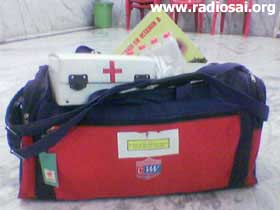 |
The 'Premabandham' kit - innovatively teaching cleanliness through love |
|
The children of the village became so friendly with the Youth that they would wait and long for their visit. As Kalyan, a Youth member says,
“The villagers initially did not know who we are and why we came there. But later, they got so attached to us that they would all assemble around us as soon as we came. They would offer us buttermilk and pamper us. The children would keep running around us. They also learnt a number of Bhajans. I do not know how much impact the project had on their lives, but it has surely left a deep impression on me.”
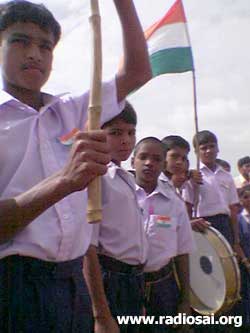 |
Inspired by the Sai Youth, the village children display their spirit of patriotism |
|
|
That was the invaluable bond that was established between the Youth and the Bal Vikas children of the villages. For every Youth it was a memorable experience just like Kalyan’s.
“I never knew that the villagers lived in such pathetic conditions. When I first saw them, I decided that this project was a golden opportunity to do something concrete. I would go every weekend to the village and take up Bal Vikas for the children. It has been such a satisfying experience,” says another Youth member.
So ultimately it was love which transformed the children. To give more exposure to these children from the village, the Youth organized another interesting event. They did a small camp in the campus of the Sri Sathya Sai Vidya Vihar School, Hyderabad so that children from the city could have one to one interaction with their counterparts from the village and be sensitive to their needs.
When the Youth members narrated the conditions under which the village children were studying, the children of Vidya Vihar School immediately came forward and gave away pencils, toys and may other such things. The senior students shared their study materials which were photocopied, spiral bound and distributed all across the state during the project. It was indeed a moving sight to see a practical demonstration of sacrifice and sharing in the students of the city.
|
All these efforts yielded positive results and within six months all the 110 schools had proper building and teaching aids while the students were given school uniforms, Premabandham kits, study materials, notebooks, pencils, erasers, slates, etc. There were even many teachers appointed by talking to the District Education Officers. The culmination of this grand project happened in Prasanthi Nilayam when in 2004 more than 8000 Youth from all over the state assembled for the Dasara festival and performed a delightful drama in the divine presence.
"Lakshala Lakshaala" |
|
|
|
The Sai Youth's scintillating offering to Bhagawan in October 2004 in the Sai Kulwant Hall |
|
|
|
“How can I take money from you?” – The Fruit Seller
All the beneficiaries of this project express their deep sense of gratitude whenever they see Sai Youth. For instance, it so happened that one day, one of the Youth members, Raju, was in the fruit market picking fruits. He was dressed in white as he had just returned from a seva activity, that day being a Sunday. As he was trying to bargain for some custard apples, the fruit seller asked, “You are Sai Baba people, isn’t it?”
Raju was taken aback. He said, “Yes.” The fruit seller’s expression changed immediately. With glee he said, “You can take the whole basket for free.” Raju was at loss. “What’s wrong with this person?” he began to ponder. The fruit seller then replied,
“Sir, you have constructed a school in our village. Because of that my child is getting education today. How can we take money from you?” There were tears in his eyes.
Raju stood there transfixed. This incident probably just about sums up the impact the whole education project has had on the villagers across the state. In the words of Sri Y Srinivas, President of the Grama Seva Trust,
“The results have been fantastic. This was the first time the whole state worked on a single theme as a cohesive unit. It was a challenge, no doubt, to work on a focused time bound activity with tangible deliverables. But the amazing results have now only encouraged us to take up more such statewide rural projects.”
V. The Pharmacy Bank - A Pioneering Concept
And since then the Grama Seva Trust indeed has taken up many more such state wide projects, notable among them being the establishment of the Sri Sathya Sai Pharma Bank in 2005.
After statewide education, healthcare was the next major focus of the Trust. The Youth deduced that medical camps were one of the most common activities undertaken by every Samithi in the state. While the doctors available did not charge for their services, the Organisation ended up spending huge amounts in the purchase and procurement of medicines. The Youth wanted to explore if they could spare the Organisation this expenditure. Their idea very simply was to set up a Pharmacy Bank located in Hyderabad from where medicines could be supplied to wherever there is a need across the state freely.
At the drug controller’s office, they made presentations of their concept and explained their idea and intentions. Fortunately for them, the man in charge was a devotee of Bhagawan. He immediately endorsed the idea and even agreed to organize a Pharma Manufacturers’ Meet.
The meet was held in the premises of Bhagawan’s temple in “Shivam” and had representatives from most of the Pharma companies of Hyderabad. When the Sai Youth explained their idea of the Pharmacy Bank many of the representatives showed a positive response and came forward to donate medicines on a regular basis to the bank.
They were impressed by the noble cause of the project. “Around 20,000 patients would be benefited every month by this effort,” the Youth calculated.
|
|
|
The Pharma Manufacturers' Meet in Shivam |
|
‘Sri Sathya Sai Aushadalayam’ is Born
It was then that the Pharmacy Bank was registered as ‘Sri Sathya Sai Aushadalayam’ on January 4, 2005 . And since then it has served thousands of patients all across the state. However, there is an interesting anecdote connected to this. When the Pharmacy Bank was to be registered, there was a minor hiccup as in the Government’s rule book there was no clause for any registered Pharmacy to disburse medicines free of cost. This was an unheard of undertaking and the Government did not know how to register such a body. So, interestingly a new clause was added to the existing Registration Act which incorporated the allowance of a Pharmacy set up for disbursing medicines free of cost. Bhagawan’s projects have always baffled Government officials be it their concept, timely implementation or perfect execution. And this was yet another revealing tale.
So the registration done and working with perfect coordination, the Pharmacy Bank is now a great success story of the Grama Seva Trust. On a regular basis medicines are being sent to various places across the state to conduct medical camps, mostly to the areas where there is sustained medical service activity all round the year. The Grama Seva Trust has now labeled these centres as ‘Grama Seva Kendras’. Incidentally, Cholamaari is now one of the Grama Seva Kendras.
A Sample of the Pharma Companies That Support The Pharmacy Bank |
Some of the Regions Which Received Medicines For Sustained Medical Camps |
The Pharma Company |
No. of Units |
The Grama Seva Kendras |
No. of Units |
| ARSA PHARMA(MARS) |
13625 |
CHOLAMARRY |
151471 |
| DR.PUSHPA & DR.RAMANA REDDY |
163468 |
ELURU |
177896 |
| DR.REDDY'S |
683901 |
KAKINADA |
32812 |
| ESPI INDUSTRIES & CHEMICALS PVT. LTD. |
9840 |
KERELLY |
16201 |
| INDU PHARMA |
11228 |
KUKATPALLY |
14880 |
| INVOMED |
7690 |
MEDIPUR |
2353 |
| MARS THERAPEUTICS & CHEMICALS |
10255 |
MEHDIPATNAM |
59675 |
| PHARMADEEP REMEDIES |
4657 |
POLLA |
292394 |
| SRI KRISHNA PHARMACEUTICALS LTD. |
8000 |
POTEPALLY |
6808 |
| SUZIKEM DRUGS PVT.LTD. |
46070 |
SAROOR NAGAR |
36850 |
| TINI PHARMA |
3060 |
TANUKU |
117349 |
| TRIDENT PHARMACEUTICALS PVT. LTD. |
3500 |
VIZAG |
64295 |
More than thirty seven lakhs worth of medicines have been dispatched to date by the Pharmacy Bank and there are twenty companies which regularly donate to the bank. This is truly a great example of how a neat idea could do wonders. If we look closely, we can see that here too the Youth played the role of an effective enabler. Without a paisa of expenditure, the Youth is now removing the distress of hundreds of villagers just by bringing the Pharma companies and the Sai Samithis together. An idea can change the world, they say and the Youth is precisely doing that albeit within the confines of a single state.
VI. Building Houses - Rebuilding Lives – The Youth's Recent Project
Having contributed on the education front and on the Healthcare front, the Youth next wanted to do more. They wanted to go into the interiors of the state - places where no Government machinery or voluntary organizations ever reaches - and look into their problems. This time, they chose first the district of Prakasam. They extensively toured this district looking for a village where the need is greatest. In two days, they visited twenty seven villages - until they found Guntapalli.
Guntapalli was the kind of village they were in search of. Cut off from mainstream life and leading an island-like existence, the nearest road to the village was 6kms away. This meant if a villager had to catch a bus, he/she would have to walk at least 6 kms.
Moreover, there was no Primary Health Center in the village. There was a primary school but it was functional only once a week. And if any villager needed medical attention, it was not before he traveled 20 kms. The road to the village was arduous, to say the least. Full of rocks and mud, it was a challenge for the vehicle as well as the passenger to reach the village in one piece. And how were the houses? Sorry, there were only dilapidated huts, which looked more like slums. It was in this condition that the Sai Organization found the village.
The Youth, after a lot of discussion and deliberation, decided that they would work first to provide proper dwelling places to the villagers. Initially, their idea was to provide asbestos roofs and cement and with the help of the villagers build the walls. However, this changed dramatically when someone suggested, “Why don't we try the Government. Maybe they will have some schemes for the villagers?”
|
|
 |
The road to Guntapalli was as pathetic
as the village |
|
The Youth team immediately met the Collector of the district. It was heartening when the Collector, Smt. Udaya Lakshmi, confirmed their notion and told them, “Yes, there is a housing scheme available,” and extended her full support to the project. She was impressed with the noble intentions behind the project.
According to the scheme, the Collector explained, the owner of the house should pay an initial sum and get a basement for the house constructed. Only then would the Government provide the remaining amount for the house to be completed.
How Swami Helped Through Trying Times
This scheme appealed to the Youth. The villagers however, were not in a position to finance themselves even for the basement. And so, the Sri Sathya Sai Grama Seva Trust decided to take care of the initial funding. To support them in this venture was the telecom giant, Nokia.
“Finances were never a problem,” says Surendra, Youth coordinator of Prakasam District, “By Swami’s grace, everything fell in place. I remember Swami’s words - He had said in the interview that He blessed us with in 2003 that we should work on rural development and He would ensure that money comes at the snap of our fingers. That is what exactly happened in this project.”
With funds available, the Youth of the Prakasam district went into action and started collecting information about the logistics involved. Within days, all the necessary Government clearances were obtained, thanks to the local MLA (Member of the Legislative Assembly). Twenty eight houses were sanctioned for the village in the first phase of the project.
|
|
|
The condition of the houses when the Sai Youth first surveyed the village
|
It was no mean task getting materials like bricks, cement, steel, etc., to an isolated place like Guntapalli which had only stones and mud as roads. But if the project proceeded, it was purely because of the constant prayer of the Youth and their determined effort. The commitment of the district Youth was commendable. In fact, one of the Youth members would drive down 200 kms every week to ensure that the project moved as scheduled. The villagers too showed great unity and put in their labour and sweat in the construction work.
 |
The village now has a water storage tank |
|
|
While the construction activity was going on, the Youth noticed that there were other crying needs in the village. The villagers did not have any medical facilities. They did not even have proper clothing to protect them from the winter.
The Youth soon organized three medical camps and one eye camp with the help of the Sai Organisation. They also distributed blankets for use during the cold months. The school children received school bags, books and pencils. Although the village had a well with water, they had no storage facility. The Sai Organization got a water storage tank made.
“All the villagers are changed today” – Surendra
All these activities went a long way in building a healthy rapport with the villagers. Their suspicions reduced with every new activity.
|
“The villagers were not responsive initially. They had lost faith in humanity. They did not trust us even when we said that we had come there to help them,” says Surendra, “But today, they are a transformed lot. They do their own work. They respond with love. Many of them have given up bad habits like drinking and this was the change we wanted to see.”
After three months of relentless effort, the first phase of the project saw twenty-eight houses finally completed. The 11th of June 2006 was set as the inauguration date. The inauguration ceremony was no small occasion. It was replete with celebrations. The Sri Sathya Sai Grama Seva Trust president, Sri Y.Srinivas and Sri Sai Prasad Gollapudi, Director, Nokia who is also a member of the Sri Sathya Sai Grama Seva Trust, arrived in the village along with the District President of the organization and a few elders. The morning began with the hoisting of the organization flag. The local MLA, Sri Pagadala Ramayya, then inaugurated the houses. He was so touched by the project that he declared that a road has been sanctioned to the village and very soon there would be even be bus services to the village.
|
|
|
Hoisting the flag of the Sai Organisation on the
Inauguration day |
|
A director of Nokia speaking to the villagers
during the ceremony |
The villagers were ecstatic. They received new clothes from the Youth that morning. With beaming faces and adorned in their new sarees and shirts the villagers entered their new homes. But wait a minute. They did not enter first. They would first take Swami’s padukas into the house and then set their feet inside. Such is their love for Swami now. Many of them did not even know who Sai Baba is just a few weeks ago.
“We want to see Sai Baba now” – Dastagiri
“We have not seen Sai Baba. But now, we all want to see Him,” said Dastagiri, a Youth from the village, “If He can inspire so many youngsters to come so far and construct houses for someone who they don’t even know, He must be great indeed. We have decided that we will go and see Him after all the houses are completed.”
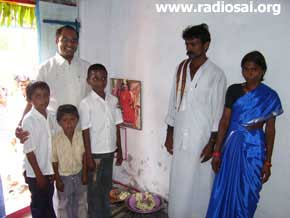 |
Sai Youth sharing the joy with the young members of a family in their new house |
|
|
Ramanjaneyulu, another villager said,
“We had lost faith in all of humanity because over the years many people have visited this place and promised to do many things. But, no one has done anything. But now, you have proved our conviction wrong. There are people who do what they profess to do.” Ramanjaneyulu’s eyes were wide and his face suddenly had a rare shine.
“For me, it is Christ who has come” – A Christian Lady
The villagers were not joyful - they were in bliss. It was an experience they never had before.
“We have heard of stories where God comes to give food, clothing and shelter as told in the Bible. But here we see you giving us just these. We feel that Christ has come to give us all this,” said a Christian lady of the village.
|
Their cup of joy was full and overflowing. So too were the hearts of the Sai Youth. Even for them it was a rare experience of inner joy and tremendous peace. Swami says, “What joy you experience doing selfless service cannot ever be compared to any amount of worldly accomplishments.” The Youth had practical experience of this.
Of the 350 houses sanctioned in the Komarolu Mandal (to which Guntapalli belonged) by the Government only 28 houses in Guntapalli village have been completed. And all these houses complied with the directives given by the Andhra Pradesh State Housing Corporation (APSHC). They were all 17 feet by 9 feet halls with a bathroom and a toilet. They all had RCC (Reinforced Cement Concrete) structures painted in beautiful colours with a door, window, shelves and an attic. The houses truly are a testimony to Bhagavan’s Divine Grace and the constant perseverance and prayer of the organization’s Youth.
It was also the first time that the Youth had undertaken a housing project of such magnitude in a district. And the success has now spurred all the Youth to do more with greater confidence. “It has given us really tremendous motivation to undertake long term projects which will have a sustainable impact,” says a senior member of the Grama Seva Trust. The Youth is now busy completing the second phase of the Project wherein they will be offering another thirty two houses to the villagers of Guntapalli.
|
|
|
The story of Guntapalli - from God-forsaken
to God-blessed |
|
The Irrepressible ‘Sai’lent Revolution
What the Sai Youth of Andhra Pradesh has achieved through the Sri Sathya Sai Grama Seva Trust and with support of the Sai Organisation in just three years is nothing short of a revolution. It is surely a silent revolution (the press seldom carries such stories in their front pages), or rather a “Sai”lent revolution which, when it gains more momentum, will one day change the complete profile of the state – be it demographically, economically or spiritually.
 |
Healing Hearts....in Millions |
|
|
And just recently the Youth have embarked upon another project, again spanning the whole state of Andhra Pradesh, but much larger in its scope and impact. Christened as “HEART”, this is a five pronged project which will cater to the Healthcare, Educare, Agricare, Rural Infrastructure and Transformational activities of 80 clusters of villagers, (mind you, it is 80 clusters which could mean at least 500 villages) in the twenty three districts of Andhra Pradesh.
Fifteen thousand Sai volunteers over four years will complete the project. Just imagine what it will do to India, when every state of the country has such a critical mass of enlightened Sai Youth going into the villages. The golden age for India will have arrived, or at least, will not be spoken of as a fanciful utopia. When God walks on earth, peace, righteousness and love are no longer utopian dreams.
|
Dear reader, while what the Andhra Pradesh Sai Youth have done is commendable, we are doubly sure that this is no isolated activity in just one state of India. In every region of India, the Sai Youth are making a difference and we at H2H would consider it as a blessing to share all these ‘labours of love’ with the larger Sai family spread all over the globe. So please let us know. Let us share and let us fill the world with selfless love.
- Bishu Prusty
Heart2Heart Team
We are grateful to Sri Y Srinivas, Sri Venugopal and Sri Krishna Raju for their active support and help in the making of this article.
How did you like this cover story, dear reader? Was it informative and inspiring?Did it give you any new and noble ideas? What suggestions do you have for our future cover stories? Please let us know at h2h@radiosai.org. Please mention your name and country when you write to us. Thank you for your time.







